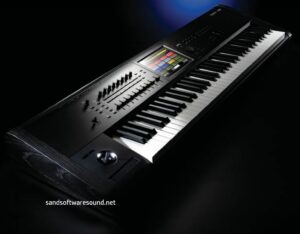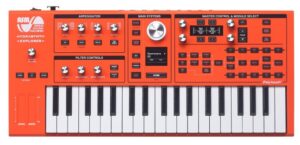The big reveal from ROLI is a 49-key version of the LUMI Keys, now known as the ROLI Piano M. Price is $599 USD/€599 (RRP) with a very limited-time introductory price of $399/€399. First orders will ship in May.
Add color to your musical ideas with four octaves of full-sized, semi-weighted keys, each with per-key pitchbend, polyphonic aftertouch, and vibrant Brightkey illumination. ROLI Piano is MPE-ready, perfectly portable, and designed to inspire. Add Airwave, and you can even play the air above your keys – seriously. [ROLI]
ROLI made a few additional improvements in addition to 49 full-size, full-throw keys:
- Sustain/expression pedal input
- MIDI OUT (3.5mm TRS)
- USB-C class-compliant MIDI
- Diminuitive size: 27.5″ x 8″ x 1.8″ (mm x 200 mm x 45 mm)
- Light weight: 7.7 pounds (3.5kg)
Basically, you get an MPE-compatible MIDI controller for not a lot of money. This might put a dent into Keith McMillen K-Board Pro sales.
Not to pick on ROLI specifically, but I have a thing against any keyboard shorter than 49 keys. Look, I play real music. I need Middle C and two octaves above and two octaves below. This minimal range lets my left hand wander a little bit and my right hand can play most melodies within range of the human singing voice.
The LUMI Keys (mine is a “Keys”) has 24 keys. Right off the top, forget two hands. No matter where you put Middle C, there’s a chance that you will run out of keys. Because LUMI Keys is designed to snap together, it is missing the C above Middle C, too. I can’t count the number of times my pinky finger is flapping in the breeze because that C key isn’t there.
I will give credit to ROLI for rolling out a longer 49-key keyboard with full-sized keys. My LUMI keys has the short scale (Stretto, 5.5″ per octave) keys. At this point, I adapt to mini-keys when necessary. Still, I prefer full-size keys (either synth- or piano-width).
I wish ROLI well. Recently, I bought a 48-key Novation Launchkey Mk4 and love it (review on the way). I’ll be keeping the ROLI LUMI Keys for MPE experiments and for occasions that require extreme portability and built-in Bluetooth MIDI.
Novation and Klevgrand
Novation and Klevgrand have something in the works, thanks to their new partnership agreement. They are teasing new software designed specifically for Novation controller users. March 2025 is the target timeframe. [As we used to joke in software development, “Is that the beginning or the end of the month?”]
Novation already bundle a few Klevgrand plug-ins with Launchkey. (I still need to get to them!) Klevgrand’s user interface (UI) is super clean and tidy, so I’m looking forward to the fruits of their collaboration. If you are a Novation user, keep your eyes open and look for offers and activations later this year.
Floobydust
CME realize that their greatest asset is their software. Thus, they announced the C2MIDI Pro USB5-pin MIDI cable with filtering, routing and mapping smarts. The U6MIDI PRO, WIDI Master and MIDI Jack are in daily use, here. I just say, these guys know this domain and produce reliable, affordable MIDI products. The C2MIDI cable will sell for $29.99, shipping February 2025.
Studiologic have announced the SL Mk2 controllers: SL73 Mk2 ($500 USD) and SL88 Mk2 ($500), and SL88GT Mk2 with acoustic-weighted keys ($1,000).
Behringer are showing the BX1 DX1 knock-off, the PRO-16 Sequential Circuits re-do, and the JT-16 Analog Polyphonic Synthesizer.
Copyright © 2025 Paul J. Drongowski
















